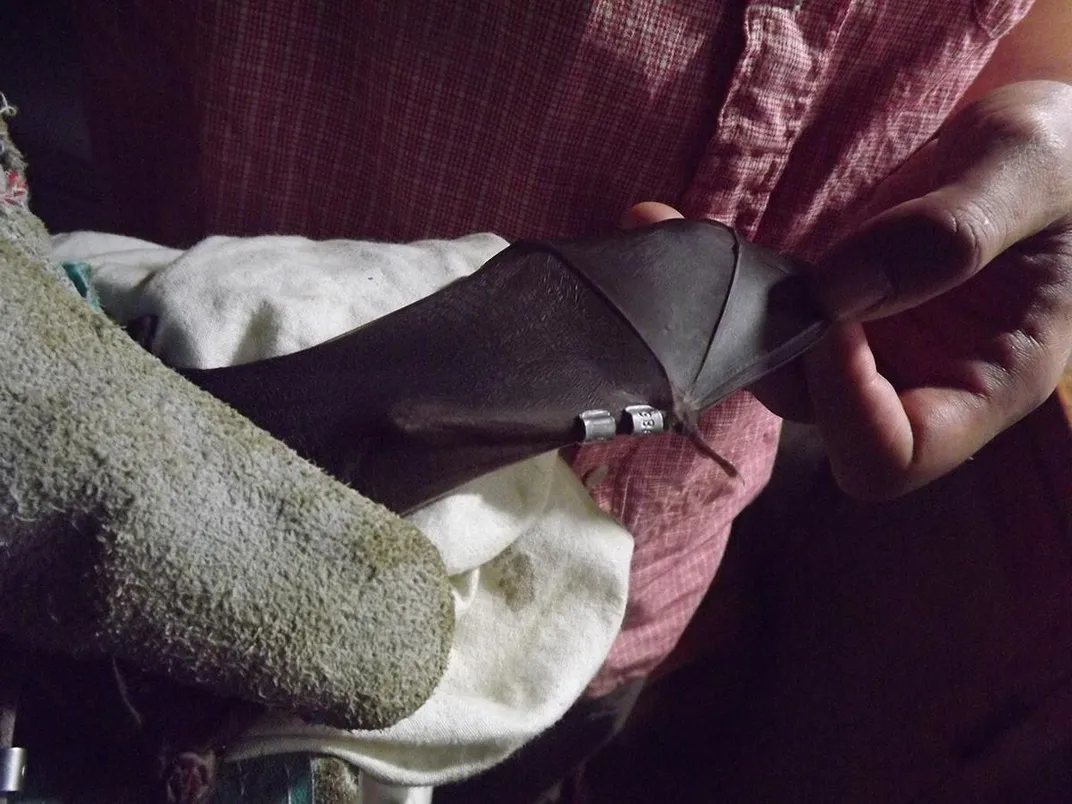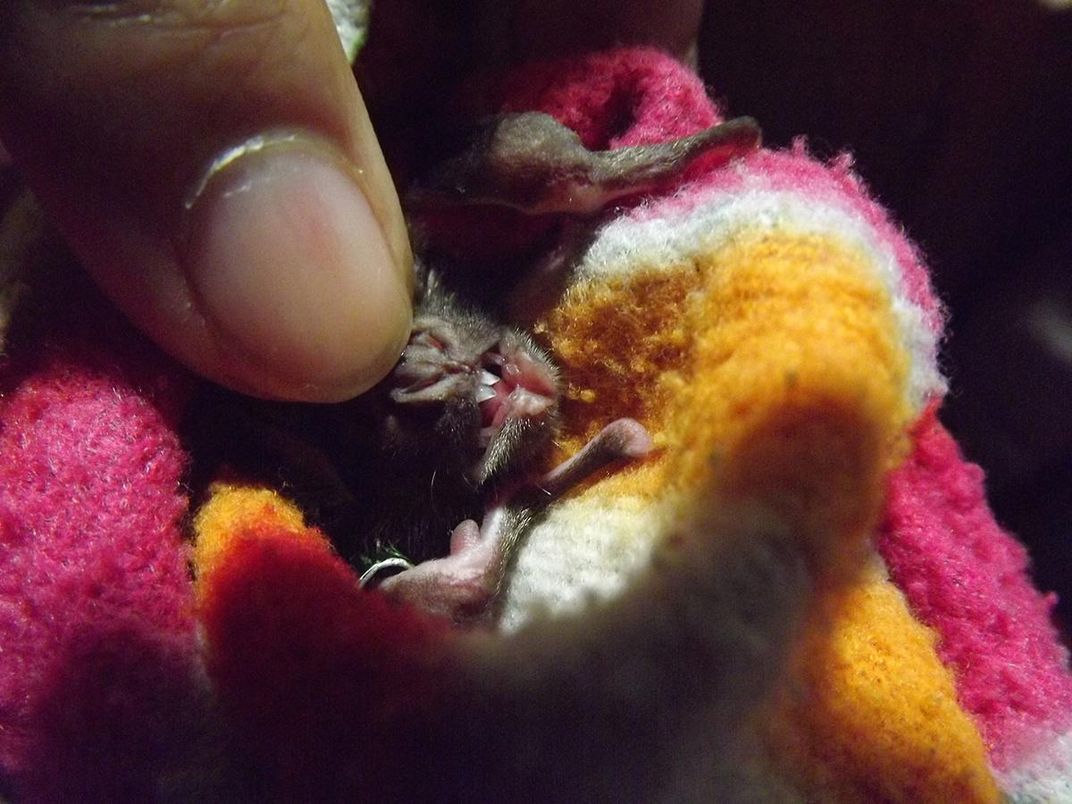What a Vampire Bat Can Teach Us About the Economics of Friendship
A Smithsonian scientist says important lessons about making friends and sharing can be learned from these blood-sucking creatures
:focal(815x330:816x331)/https://tf-cmsv2-smithsonianmag-media.s3.amazonaws.com/filer/c4/5e/c45e215d-7646-4a2d-9586-611fa177e8c7/desmo-boden.jpg)
The blood-sucking vampire bat may have a lesson to teach us on what sharing is all about. If you don't believe this, Gerald Carter can prove it with his new research paper, "Social Bet-Hedging in Vampire Bats." By observing how vampire bats make friends and share food, Carter has figured out some evolutionary facts of friendship that could potentially apply beyond the world of bats and blood.
“This is what we do every night,” he says, slipping through a screen door into a dark, wire enclosure with black plastic tacked up around the walls. Vampire bats dangle from the corners of the ceiling like fuzzy brown fruit. There is a strange, thick animal scent in the humid Panamanian air. At the Smithsonian Tropical Research Institute (STRI) facility in Gamboa, Panama, Carter, a behavioral ecologist, has been able to study vampire bats both in the wild and in captivity for years.
Wearing a special glove, he picks out one particular flapping little vampire bat and examines it. “We come in here and the bats have these little bands and their names are just their bands,” Carter says. “This one is Shiny, for the shiny band.”
Shiny looks annoyed. Also cute. Carter stretches Shiny's wing out to demonstrate the little grasping claws used to grip and climb. Shiny has a fuzzy belly and very soft, velvet-like wings. The captive bats have allowed Carter to ask a pretty big question about the bats and about living things in general.
Vampire bats, native to Central and South America, feed exclusively in the wild on blood from live animals. If they go about 48 hours without a meal, they die. These bats have a strategy for staying alive when food is scarce. They can regurgitate blood in order to feed one another, though they won't do this for just anyone. They will only feed certain family and friends.
/https://tf-cmsv2-smithsonianmag-media.s3.amazonaws.com/filer/b0/09/b009c4c4-563b-46ef-81c9-448c0beb50cf/dscf8794web.jpg)
Carter can take Shiny out of the bat enclosure for a night and keep him in a separate cage where he doesn't eat. Then on his return to the other bats, he can observe whether any other bats are willing to feed Shiny. Vampire bats tend to have very strong relationships with their mothers and daughters and other close family. Investing in those relationships through grooming and just hanging out together tends to mean that those family members will reliably provide food when needed. But what happens if Shiny's mom isn't around?
The act of feeding is inherently more dangerous for vampire bats than it is for, say, fruit bats. A piece of fruit doesn't roll over and squish you. Vampire bats seek out animals that are asleep and use their ability to sense heat to figure out the best place to take a bite. That bite is risky. If it hurts, the animal might fight back.
Carter usually wears a glove to handle vampire bats, but was bitten once while trying to stop an escaping bat with his bare hand. “It took a chunk out of it, surprisingly not painful,” Carter says. “The teeth are so sharp. It's a tiny little nick and then it bleeds so much for the size of the wound. See those incisors?”
He holds Shiny's lip open to reveal a pair of tiny white triangles. “Like what a rodent is chewing with,” he says. “Just razor sharp little things and then there's a gap. What they do is take a little diamond-shaped chunk out of the skin. . . like someone took a spoon-shaped razor.”
“I would definitely say that they are the hardest bats to physically handle because they have got more degrees of freedom,” Carter says. “Look at this bat, walking around here in the cage, these are the only bats that do that. Look at how it jumps. . . They land on the ground and then slowly creep up like a spider. They will feed on a hoof of a horse or the side of a pig. If the animals rolls over or kicks back then it will kill the bat so they are extremely fast.”

These bats can run and leap. Other bats don't do that.
Vampire bats evolved in a world very different from today's. Central and South America was once home to a whole community of native megafauna that the bats probably fed on—big, warm-blooded animals like mastodons, gomphotheres, giant ground sloths, giant armadillos, toxodons, with strong heat signatures for hungry bats to zero in on. But all of those began to rapidly plummet into extinction about 15,000 years ago. In their place came human beings and later the cattle, horses, pigs and chickens brought by Spanish colonists. The bats have had to adapt.
They do not drain enough blood to kill their hosts. To the contrary, vampire bats often develop specific preferences for individual animals that they will return to feed on again and again. They can pick a favored cow out of a herd of dozens.
If a vampire bat like Shiny cannot find a sleeping animal to feed on, and his mother is either dead or has chosen a different roost for the night, he had better have some friends to fall back on and ask for a favor. But not every bat has a lot of friends. Carter has found that individual bats may be more or less likely to groom unrelated bats and establish friendships with them.
In STRI's bat enclosure in Gamboa, several infrared cameras are set up to record the bats as they interact with each other and eat from several special feeders that look pretty much like what one would use to supply water in a bird cage except that they are filled with a dark red blood that was supplied by a local butcher and specially processed to ensure that it is safe for bats to eat. For hours every night, Carter's assistants observe and take notes on which bat hangs out with which other bats and who is willing to feed whom under different scenarios.

“It's like a soap opera,” he says.
Carter's conclusion is that there is a real advantage to making friends, but that advantage is only observed when a starved bat doesn't have access to close family.
“I definitely look at it from an economic viewpoint,” Carter says. “The idea of this paper is how does a bat make a decision about the number of relationships it creates and the strength of those relationships? The idea I have is that if your mom is your only food sharing partner and she dies, or isn't there when you need her, then you're screwed. So you should not be putting all of your eggs in one basket. It's like stocks. You should diversify. . . You don't just want to consider the return rate. You want to minimize risk, as well.”
Gerry Carter steps back through the screen door between the lab and the enclosure and releases Shiny, who heads straight for the corner of the ceiling among a cluster of other bats. One of them begins grooming him almost immediately. Grasping his body and using it's mouth to straighten out his fur. Perhaps these two will eventually feed one another.
Other scientists have also tried to study the economics of friendship. Mostly using primates. The difficulty is with the fact that primates need to be trained to participate in a study. Perhaps they press a button to give food to a primate in an adjoining cage, while reducing their own available food.
“Everything becomes about the context of the training,” Carter says. “You might think you are testing thing A but really you are showing thing B. . . those experiments, although interesting, tend not to resolve controversy.”
The unique opportunity that vampire bats offer is twofold. First, the fact that starvation can be so rapidly acute. Second, the fact that they naturally regurgitate blood for other bats without training. There is no question as to what the bats are doing.
It takes one to two months of regular interaction and grooming between two unrelated vampire bats before one is likely to be willing to feed the other in a crisis.
The captive vampire bats will hopefully have more to teach Carter and other researchers before they are eventually released back into the wild. Carter described another economic concept that researchers at STRI would like to study with vampire bats. It is called 'producer-scrounger dynamics.'
“The hardest thing is making the bite,” Carter says. “You make the bite and now you have this spout of blood, dribbling.” Sometimes other bats would rather get in on a sure thing instead of taking on the risk of making their own bite and potentially waking up their host animal.
“Picture a bunch of birds spread around a field,” Carter says. “Nobody knows where the grains of rice are, hidden under the grass. You could be looking in the grass with your head down or you could scan the whole group and see where someone else has found some. You can either be producing information or scrounging from others. I think this is a possibility with bats. It is very risky to make that bite but once it is flowing you can go over there and feed. . . . Sometimes we see up to seven bats feeding from one bite.”
/https://tf-cmsv2-smithsonianmag-media.s3.amazonaws.com/accounts/headshot/JacksonLanders.jpg)


/https://tf-cmsv2-smithsonianmag-media.s3.amazonaws.com/accounts/headshot/JacksonLanders.jpg)